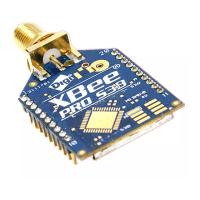Modes Serial modes
XBee®-PRO 900HP/XSC RF Modules
46
Serial modes
The firmware operates in several different modes. Two top-level modes establish how the device
communicates with other devices through its serial interface: Transparent operating mode and API
operating mode. Use the AP command to choose Serial mode. XBee-PRO 900HP RF Modules use
Transparent operation as the default serial mode.
The following modes describe how the serial port sends and receives data.
Transparent operating mode
Devices operate in this mode by default. The device acts as a serial line replacement when it is in
Transparent operating mode. The device queues all UART data it receives through the DIN pin for RF
transmission. When a device receives RF data, it sends the data out through the DOUT pin. You can set
the configuration parameters using Command mode.
Note Transparent operating mode is not available when using the SPI interface; see SPI operation.
The device buffers data in the serial receive buffer until one of the following causes the data to be
packetized and transmitted:
n The device receives no serial characters for the amount of time determined by the RO
(Packetization Timeout) parameter. If RO = 0, packetization begins when a character is
received.
n The device receives the Command Mode Sequence (GT + CC + GT). Any character buffered in
the serial receive buffer before the sequence is transmitted.
n The device receives the maximum number of characters that fits in an RF packet (100 bytes).
See NP (Maximum Packet Payload Bytes).
API operating mode
Application programming interface (API) operating mode is an alternative to Transparent mode. It is
helpful in managing larger networks and is more appropriate for performing tasks such as collecting
data from multiple locations or controlling multiple devices remotely. API mode is a frame-based
protocol that allows you to direct data on a packet basis. It can be particularly useful in large
networks where you need control over the operation of the radio network or when you need to know
which node a data packet is from. The device communicates UART or SPI data in packets, also known
as API frames. This mode allows for structured communications with serial devices.
The application programming interface (API) provides alternative means of configuring devices and
routing data at the host application layer. A host application can send data frames to the device that
contain address and payload information instead of using Command mode to modify addresses. The
device sends data frames to the application containing status packets, as well as source and payload
information from received data packets.
For more information, see API mode overview.
Comparing Transparent and API modes
The XBee-PRO 900HP RF Module can use its serial connection in two ways:Transparent mode or API
operating mode. You can use a mixture of devices running API mode and transparent mode in a
network.
The following table compares the advantages of transparent and API modes of operation:

